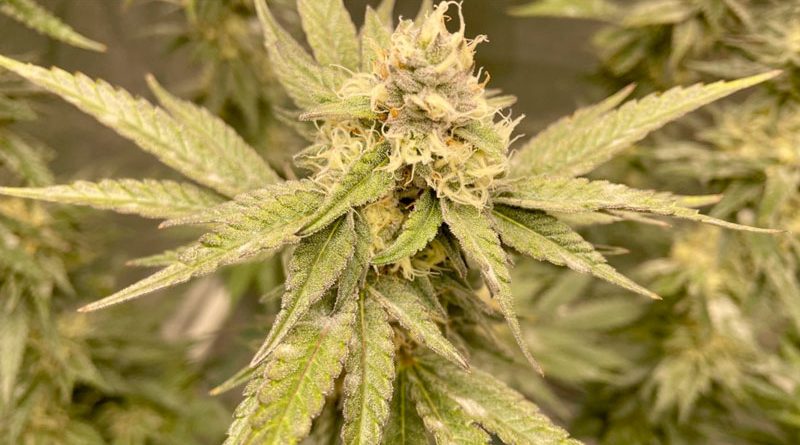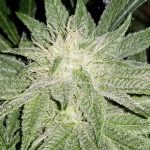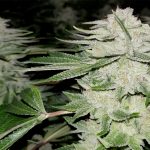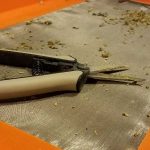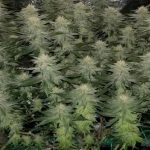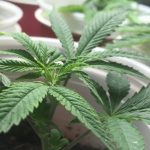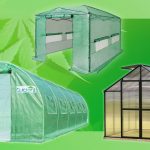How to kill powdery mildew on cannabis plants during flowering
In this post we’ll review how to kill powdery mildew on cannabis during flowering cycle. The best way to get rid of powdery mildew during flowering differs from vegetation because you , much more care is needed treating your plants flowering to avoid impacting bud quality and growth.
Powdery mildew is a common fungal disease that can affect cannabis plants in all growth stages. It is characterized by a white, powdery coating on the leaves and buds of the plant. If left untreated, it can severely damage or even kill the plant. If you get a bad case of PM during flowering, powdery mildew can make your entire crop unsmokable.
How to kill powdery mildew during flowering stage of cannabis
Killing powdery mildew in cannabis during flowering isn’t easy, but there are some techniques you can use to greatly reduce and control the problem. It’s critical you monitor your plants closely every day of your grow to look for diseases. It’s much easier to control issues like PM in the early stages versus once your entire cannabis garden is infested.

Here are the best ways to kill powdery mildew on cannabis plants during flowering, and to control it so it doesn’t return.
1. Remove infected leaves
The first thing to do to control powdery mildew during flowering is to remove infected leaves and sections of the plant. This will help prevent the fungus from spreading. Removing infected cannabis leaves can be tricky — powdery mildew spores can easily be spread.
You could spray down plants with water which will limit spore spread, a common tactic to control mold spores in general, but this moisture will likely worsen the growing environment conditions and increase PM growth. Some growers will try to put a plastic bag over infected areas and then cut off the affected branches. This limits PM spores from spreading, but it won’t block them all.
Turn off all fans when removing leaves, especially circulation fans. Discard infected leaves in the trash. Don’t compost them, or you’ll be creating a potential source for airborne problem in the future.

Heavily defoliate at the end of week 3 of flowering, around day 21 for an 8 week strain. Some methods such as scwazzing call for total removal of fan leaves, but most growers don’t go that far. Make sure to thin out small branches and fan leaves throughout the plant to increase circulation.
Defoliating too heavily during the critical growth weeks 4 and 5 will impact size of your buds and reduce your yield. Try to avoid it hitting your plants too hard, but remember it’s better to have reduced yield than PM-laden buds.
If you’re trying to kill powdery mildew in the late stages of flowering, such as weeks 7 or 8 in an 8 week strain, then you may want to heavily defoliate and remove all the large fan leaves. This will allow better light penetration to inner bud sites. Try to retain some leaf growth though, since PM usually begins on fan leaves if you chop them all off then it will have nowhere to grow but on your sugar leaves within the buds, which is much harder to control.
If you don’t catch the PM until a more advanced stage and the entire plant is infested, buds and leaves and all, then you may have to cut your losses and toss the plant.
2. How to kill powdery mildew spores without damaging buds
Killing powdery mildew on flowering weed plants is difficult because many PM controls can’t be sprayed directly on your buds. Neem oil is great for PM control on vegetating cannabis leaves, but you don’t want to spray it during flowering and then smoke it! This holds true for most other commercial PM products. But there are a few products that kill powdery mildew on cannabis without the risk.

Hydrogen peroxide: The safest but most effective way we’ve found to kill powdery mildew on weed plants during flowering is hydrogen peroxide.
You need to cover the surface of your leaves and buds. If you have a large cannabis garden or huge outdoor plants, a cheap pump sprayer may the easiest solution. But if you have a smaller grow with less plants, a better solution is to wipe down the leaves individually.
I like to use hydrogen peroxide wipes dipped into a separate bowl of hydrogen peroxide. The wipes aren’t usually saturated enough on their own to easily cover the leaf surfaces. Wiping by hand works best in the early stages of PM infection. If your plant is completely covered, it will be more of a pain in the ass.
Make sure to wear gloves and frequently rinse your hands in hydrogen peroxide while you work, otherwise you’ll inadvertently spread the disease to unaffected areas.
Will hydrogen peroxide damage your buds? A little. The pistils will look different, and you will end up impacting the trichome appearance as well. But the buds will still remain potent, and flavors and terpene profiles won’t be affected. It’s better to have slightly impacted bag appeal versus choking on some powdery mildew joints.
PM Wash: PM Wash from NPK Industries is a product designed specifically for killing powdery mildew on flowering cannabis plants. It is designed to be used with a sprayer and completely saturate all parts of the exposed plant.

PM Wash is 99.999% water, so it is safe to use right up to harvest on flowering weed. Considering it’s pretty much just water it is quite expensive. It is designed to change the pH level of the plant surface and make an environment that is unsuitable for powdery mildew growth.
We have used this product with mixed results. After several successive days of completely saturating the weed plants using just PM wash the powdery mildew showed no signs of dying. So we began alternating treatments of PM wash with hydrogen peroxide. This really seem to help, but I suspect it was the hydrogen peroxide that did most of the heavy lifting.
PM wash is pretty expensive and most of what was sprayed dripped off. It might have been more cost-effective to wipe affected areas down by hand to help remove the PM growth rather than just spraying it all. It’s certainly cheaper to buy a few gallons of PM Wash than to have to chop your plants to cut your losses, but it’s best to consider this product as part of a multi-step solution.
Other ways to control powdery mildew in cannabis: they were a bunch of recommendations for controlling powdery mildew in cannabis plants that are better suited to the vegetative stage rather than the flowering stage. Products such as neem oil, baking soda, and commercial fungicides may technically work to kill powdery mildew on leaves during flowering, but if any hits your buds you’re going to end up inhaling them. Not ideal.

If you’re trying to remove powdery mildew during week 1 or week 2 of flowering, then you should be safe. But once bud formation begins, more care is needed to avoid covering buds. By the time you’re in week 3 or week 4 of flowering and bud growth is well underway, you’re better off using hydrogen peroxide instead of neem oil or other fungicides. For powdery mildew problems in week 6 or 7, really watch what you apply.
One exception would be products that are labelled as safe to use in flowering or right up to harvest.
Green Cleaner is one of these options. It’s active ingredients are soybean and other oils and alcohol, and can fight bugs such as spider mites in addition to PM. It’s best used in vegetation or early flowering.
Trifecta Crop Control can also be used during flowering, up to one week from harvest. It uses essential oils to kill PM, spider mites, and many other pests.
If you are running into issues with powdery mildew on successive grows, then you should consider an integrated pest management (IPM) solution where are you alternate applications of several products throughout vegetation so that you always enter the flowering stage in good shape without PM or other issues. Commercial growers do it this way for a reason.
Proper IPM is critical on outdoor plants where you’ll constantly be fighting bugs and airborne diseases such as powdery mildew spores. If you’re looking to avoid using chemicals on your plants where possible on your outdoor grow, spray vegetating cannabis plant leaves with 4 teaspoonfuls of baking soda per gallon of water. We’ve never tried this technique on weed plants, but we have tried it outdoors on pumpkin and squash plants to treat PM. But you don’t smoke those, so having a little baking soda to wash off from your jack-o-lantern isn’t much of a concern.

3. Improve your growing environment
Powdery mildew spores are everywhere. Prevention is key, and the best way to do that is to improve your growing environment to prevent PM from setting in. Make sure to take these basic steps to keep the problem from returning:
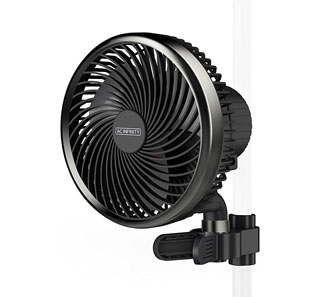
- Space out plants so they’re not touching, this can limit spreading and it also allows for better air circulation.
- Train plants to grow in a spread out pattern, and remove small inner branches to improve air movement.
- Prune large fan leaves, especially in middle and bottom areas of your weed plants. Don’t let large sections of leaves overlap each other, which creates wet spots. Lollipop tall indoor plants by removing the lower 1/3 of growth. This allows for air movement to dissipate the moisture that your leaves transpire, which in turn reduces humid zones within the canopy. Consider a heavy defoliation just before you initiate flowering, and again about 3 weeks into flowering after your plants have stretched and filled back in.
- Provide lots of circulation for indoor plants. Invest in at least two powerful clip fans for circulation in small grow tents or grow rooms, one above the canopy and the other below. All leaves should rustle gently. Large rooms need more large fans. Oscillating fans are a great option to ensure even coverage. Turn up the air flow — PM cannot grow on leaves that are in constant movement. If you’re growing outdoors, you’ll need to rely on the wind for circulation so make sure you prune heavily to space out growth and pay particular attention to airing out the middle of your plants by removing lots of fan leaves and smaller branches.
- Ensure adequate ventilation to exhaust warm, humid air. Monitor your grow room or tent’s humidity levels closely. Aim to keep it around 50%, or lower if you’re trying to control an active PM outbreak.
-

The Govee humidity monitor can send app alerts to help you better monitor your grow space. Watch for humidity spikes when your grow lights turn off, as this is when many powdery mildew problems in flowering begin and also how they get much worse. When your grow lights turn off the temperature in your room or tent will quickly drop. This impacts moisture levels in the air, which can be a big contributor to powdery mildew problems. You may maintain low humidity levels around 40-50% throughout the day, but if humidity spikes when the lights go off you still quickly develop PM problems. It can be hard to pick up on this using a cheap hygrometer/thermometer with a probe, but if you use a bluetooth-enabled humidity monitor to keep a record of grow room conditions and send app alerts so you can more easily track impact. Fix issues by making sure your temperature remains constant after the lights cycle off, such as by using a small heater near your air intake that turns on when the lights go off.
- Filter air intake using HEPA filtration. This ensures that the air you’re forcing into the tent isn’t loaded with PM spores or other bad stuff. Keep in mind that PM spores exist naturally in most environments, so each time you open your grow room door or tent flap you’re letting in air that may contain them, so filtered air intake isn’t fool-proof.
- Sanitize everything after treating plants for powdery mildew as well as between grows. Not keeping a clean environment is the number one mistake made by new or lazy growers. Once you have PM, it’s very hard to get rid of. Much better to prevent it in the first place. Soak all parts in bleach and water solution, and wash down walls, floors, lights, etc. Don’t forget to wash your carbon filter cover and ducting, light hanger straps, etc. You may want to completely replace things that you’re not able to immerse in a sanitizing solution, such as intake and circulation fans, etc. Also sanitize yourself as much as possible—don’t enter your grow area in the same clothes and shoes your wore earlier to weed your garden.
- Avoid buying used grow tents, lighting, or grow room equipment. New growers looking to save money may be tempted to buy used grow equipment on craigslist. But you’re also buying someone else’s problems. It’s nearly impossible to completely eliminate pests or diseases from some equipment, so you may be getting spider mites or PM spores along with that “barely used” grow light. Use caution.
- Avoid overwatering: Overwatering your plants can create a humid environment that is favorable for the growth of powdery mildew. Make sure to water your plants only when the soil or grow medium is dry, and avoid getting water on the leaves. For new growers who hand-water, try lifting your plant containers to gauge how dry they are. Plants need to dry out to encourage stronger root growth and avoid other problems, so pay attention to when you water and how much you use. For hydroponic mediums like coco coir, you don’t want to let the plants dry out like with soil or you’ll reduce the benefits of hydro growing, but if you over-water or don’t remove runoff you may increase moisture levels to unsafe levels for PM growth.

4. Controlling powdery mildew after harvest
If you notice powdery mildew on flowering cannabis plants and were able to control it but not completely eliminate it, then all is not lost. The best approach to removing powdery mildew from weed buds after you’ve cut them down is the Jorge Cervantes bud wash technique.
The Cervantes bud wash technique uses a light solution of hydrogen peroxide in a large Tupperware container. After cutting a branch and removing all the large fan leaves and any parts with visible powdery mildew, the branch is immersed in the peroxide solution and gently shaken. This will kill the PM, and it will float to the top of the solution depending on how heavily you’re infected. You then rinse the branches well with clean water and dry the visible moisture quickly in front of a fan. Then you proceed to dry your weed plants as you normally would.
The Cervantes bud wash method does impact the appearance of the finished buds. So it should only be used when necessary to clean your plants of PM (or for outdoor plants to remove bug shit and other contaminants). Check out Jorge’s video here to see a full demonstration. We have used this in the past and it worked well enough with minimal impact to final buds.
Jorge Cervantes- Washing Away Powdery Mildew shows how to wash powdery mildew from cannabis flowers immediately after harvest.
Summary: How to kill powdery mildew on cannabis plants during flowering stage
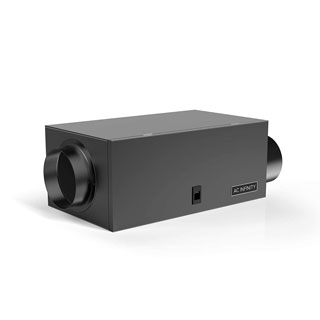
By following these steps, you can effectively kill powdery mildew on flowering cannabis plants and keep them healthy.
Monitor plants closely and remove infected leaves quickly. Use caution when treating flowering weed plants for powdery mildew to avoid harming buds with most commercial treatments or fungicides.Use hydrogen peroxide for best results during mid to late flowering (weeks 3-8).
Pay attention to proper pruning and training techniques during vegetation to facilitate air movement through the plant. Focus on improving your grow environment to prevent further powdery mildew growth outbreaks. Filter your air intake with a HEPA filter to prevent spores from entering. And remember to always sanitize your grow environment in between grow cycles.
While it’s not possible to totally kill powdery mildew in flowering weed plants, taking these steps to mitigate PM issues and prevent new outbreaks will help ensure best results.



